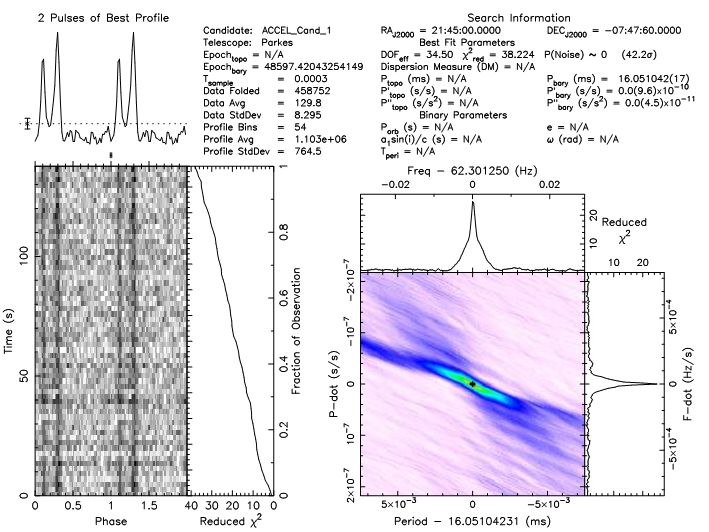Thanks to the recent accomplishments in the pulsar astronomy, now it has become possible to do a lot of science with pulsars. Potential practices include, testing general relativity, indirect detection of gravitational waves, etc. In this domain, the applications involved with millisecond pulsars (MSPs) are abundant majorly due to the precision of their orbital period, allowing to make models using pulsar timing and further research. However in this article I’m not going to discuss too much about such applications, rather I’d try to highlight the the idea behind determining and calculating the pulsar period for a given time. (It’s known than the pulsars generally slow down as they age, loosing their rotational energy)
There are databases of pulsars out there enlisting the known pulsars detailing their numerous parameters and one can query such an archive by means of multiple variables to customize a search. One such database is ANTF (Australia National Telescope Facility: « Manchester, R. N., Hobbs, G. B., Teoh, A. & Hobbs, M., AJ, 129, 1993-2006 (2005) ») pulsar database which is a fine repository of pulsar data. Once the desired pulsar is identified, the process to calculate the value of pulsar period for a given bary-centric (with respect to the center of the mass of the solar system) time is straight forward. You will need to know the values for period (P0), period-derivative (P1) and the epoch where P0 is defined (PEpoch). Next you will need to convert the desired calender time into Modified Julian Date (MJD). There are several online converters to do this, but I have used the PRESTO based program called ‘cal2mjd’, courtesy of Dr. Scott Ransom.

Then we can use the following relation to determine the predicted period of the pulsar (P_pred) concerned.
P_pred = P0 + P1 * delta_T
where; delta_T = (MJD – PEpoch) * 86400.0
Now let me give an example to see how this works numerically in the case of the known pulsar PSR J2145-0750.
The ANTF catalog gives following data for this pulsar.
PSRJ J2145-0750 RAJ 21:45:50.46412 3.000e-05 DECJ -07:50:18.4399 1.400e-03 DM 8.9977 1.400e-03 PEPOCH 53040 F0 62.2958878569665 6.000e-13 F1 -1.15588E-16 3.000e-21 PMRA -9.66 1.500e-01 PMDEC -8.9 4.000e-01 POSEPOCH 53040 BINARY T2 PB 6.83893 2.000e-05 ECC 1.930E-5 6.000e-08 A1 10.1641080 3.000e-07 T0 53042.431 3.000e-03 OM 200.63 1.800e-01 OMDOT 0.06 6.000e-02 PBDOT 4E-13 3.000e-13 RM -1.3 7.000e-01 PX 1.6 5.000e-01 A1DOT -0.3E-14 3.000e-15 DM1 -2.2E-4 4.000e-05 UNITS TCB
Above I’ve indicated in RED the basic information required for this calculation among with numerous other characteristics. Although the period (P0) and period derivative (P1) are not given directly here, they can be calculated using the given frequency (F0) and frequency derivative (F1). The trivial relations are as follows.
P0 = 1/F0
P1 = (-1/(F0)**2) * F1
In this example I’m going to calculate the predicted period at 14:15h 09th September 2014 (Hanoi Local time, GMT+07:00). But if you use PRESTO’s cal2mjd program, the input calendar time should be given in GMT. It is imperative that this should be carefully noted and implemented accordingly without forgetting when you do the calculation.
cal2mjd 2014 09 09 07 15
MJD is 56909.30208333334
Now that MJD is known the calculation can be carried out imminently.
delta_T = (MJD – PEpoch) * 86400.0
= 334307700.00000083
Then
P_pred = P0 + P1 * delta_T
= 0.0160524239242938 s
Thus the period of PSR J2145-0750 is predicted to be 16.0524239242938 ms at 14:15h 09th September 2014 (Hanoi Local time, GMT+07:00). Upon close inspection of how it varies we can conclude that we have an error of ±0.0000000000001 ms as the last digit of 16.0524239242938 ms varies by 1 every hour. This gives an idea how precise the period of this millisecond pulsar is, due to its stability in the period. To highlight more about the precision, it can be shown that per every millennium, the last digit of period 16.052423 ms will change only by 1.
The calculations can be made using a simple python script and I hope this piece of writing might give you some idea about determining the pulsar period for a given time. Feel free to comment/ discuss or contact me if you need further clarifications. If needed I could share with you the python script I wrote for this task.
It is also noteworthy that this writing was inspired by work produced during my summer internship at VATLY (Vietnam Astrophysics Training LaboratorY) in Hanoi under the highly acknowledged and thankful supervision of Prof. Pierre Darriulat & Dr. Pham Ngoc Diep as a part of my 1st year Masters in Space & Applications at USTH. Thanks should also go to Dr. Scott Ransom for his immense support with PRESTO and pulsar calculations.
Hello there.
Its great to hear from you after a long gap! I am a 14 year old schoolboy who just got his first telescope and I am a keen astronomer.
Always nice to know that there are people in Sri Lanka with the same interests!
Looking forward to more posts!
Thanks!
Hey Ishira,
Thank you for your comment, looks like you’ve been following me for a while which is pleasing to know. It’s rare to hear about teenagers with telescopes in Sri Lanka and at the time I’m happy that you’re passionate about astronomy. Keep looking-up !!
Per aspera ad astra !
Desh